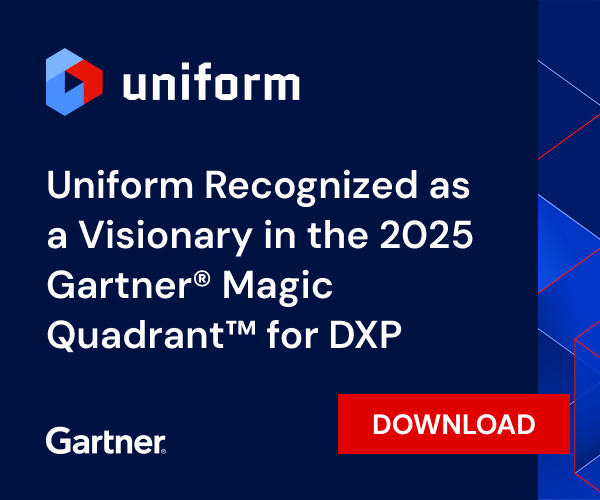Uniform blog/5 questions to ask DXP vendors before buying
5 questions to ask DXP vendors before buying
5 questions to ask DXP vendors before buying
Moving to a new vendor can be both exciting and nerve-wracking. However, migrating to a better solution shouldn’t deplete your enterprise’s resources or budget.
As you get deeper into the evaluation process, how do you separate digital experience platforms (DXPs) that promise composability and omnichannel capabilities from the solutions that scale with your business and simplify content creation and delivery?
Below are questions that can serve as a starting point for selecting a DXP vendor to ensure your solutions align with your strategic goals, project requirements, and digital experience needs.
1. Does your solution embrace a ground-up approach to composability?
Many DXPs claim to be composable but still use a first-generation approach for integrating new features into their platform. They continue to add capabilities but don’t strategically retire outdated ones, which complicates implementations and creates more technical debt than organizations can handle.
Moreover, with most enterprises using only 10 to 15 percent of their DXP’s capabilities, brands often get stuck with bloated feature suites that partially or fail to meet their needs.
To separate the solutions that are truly composable from those that are composable-adjacent, dig deep into the vendor’s capability matrix to determine if they offer easy, no-code integration with any API or service. Otherwise, vendor-controlled components make third-party integrations challenging to implement and expensive to maintain.
Ultimately, a composable DXP should enable fast, simple integration with any tool and work with preferred front-end frameworks without custom code.
2. Are there visual editing tools that help digital teams deliver personalized experiences quickly and independently?
One advantage of DXPs is their user-friendly tooling for business users, from drag-and-drop interfaces to pre-built templates and design elements. However, ease-of-use stops there if you want to build omnichannel experiences without custom integration or context switching between different systems.
Frequently, poor authoring environments are a top complaint among end users and can make or break user adoption—a metric for successful implementations. Besides looking for proof points like case studies and customer references, look for a DXP with one unified visual workspace where marketers can launch speedy campaigns autonomously.
Working in a robust visual builder enables teams to effortlessly personalize and optimize experiences, increasing speed to market and cost savings.
3. Can we connect enterprise content and data from any source using no-code or low-code integrations?
If the vendor lacks multisource data integration and content management capabilities, you could end up relying on custom code and manual workflows to integrate your preferred design system. Sticking with an all-in-one DXP vendor also locks you into a proprietary toolset that limits integration options with your front-end of choice.
Integration complexity impacts your budget. While licensing fees during the first year of your vendor contract might seem reasonable, licensing costs during years two, three, and onward can skyrocket as implementation challenges, integration headaches, and operational costs pile up.
You want a DXP housed in composable architecture that allows you to bring in your favorite tools and, if you choose, leverage native capabilities like personalization and A/B testing to optimize your digital experience.
4. Do you natively deliver generative AI (genAI) and agentic AI, or is it bolted onto the solution?
A significant advantage of artificial intelligence (AI) is its ability to boost content creation, from personalization to SEO to CRO. This is especially true when DXPs embed AI throughout the digital experience management process.
For example, genAI enables small marketing teams to generate copy and images for landing pages, headlines, product descriptions, and more in minutes and tailor it based on customer data. AI agents act as your virtual assistants, recommending SEO-rich content for web pages, enhancing and localizing copy, and maximizing user engagement.
When evaluating vendors, assess whether they can show how their AI capabilities improve conversion rates and other metrics. After all, AI-powered experiences should not only increase efficiency but also help boost conversions and revenue.
5. What will our migration process look like if we switch platforms?
Many DXPs are closed ecosystems that dictate how and when you upgrade your platform. Furthermore, your project scope and fees can climb rapidly if you migrate to another vendor.
These factors hinder business and technical teams, slow digital production processes, and reallocate much-needed resources from other strategic initiatives.
A composable DXP takes a modular approach to system upgrades, whether you have a traditional, legacy, or headless platform. You can test, implement, and sunset technologies at your own pace without replatforming or interrupting crucial operations and campaigns.
Whichever vendor you choose, they should be a flexible partner that evolves with your brand and architecture, enabling you to add the latest technologies and remove outdated ones without heavy developer involvement or hassle.
Partner with a vendor that accelerates and scales with your brand
Whether you’re an end user, decision maker, stakeholder, or all of the above, you want your concerns heard, your technology to remain intact, and your DXP to propel your organization forward.
With a composable DXP like Uniform, your digital transformation efforts are guided by a composable approach that empowers you to choose the best solutions, all connected through a lightweight orchestration layer.
Want more tips on selecting the right DXP vendor for your organization? Grab the 2025 DXP Playbook for a comprehensive plan on how to navigate your journey to composability.
Need more? Book a demo with a team member to see Uniform’s composable DXP in action.







